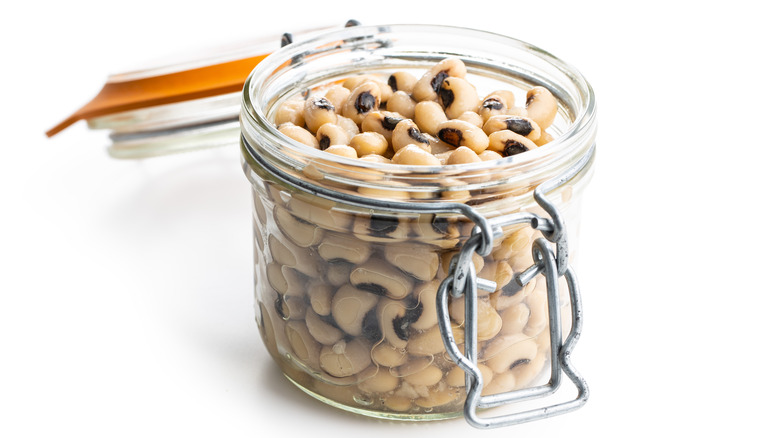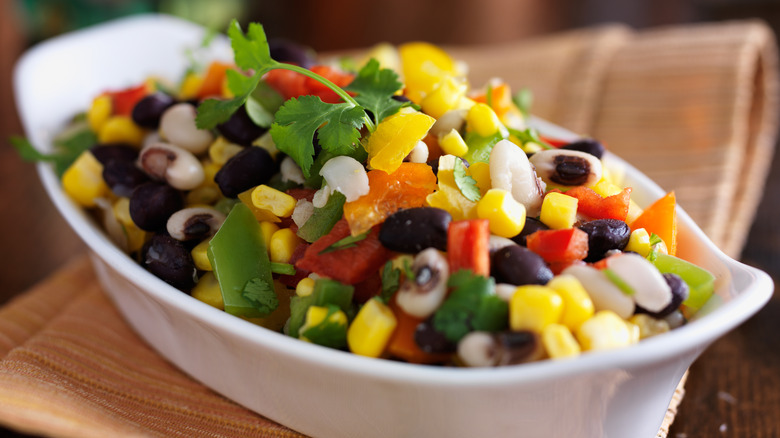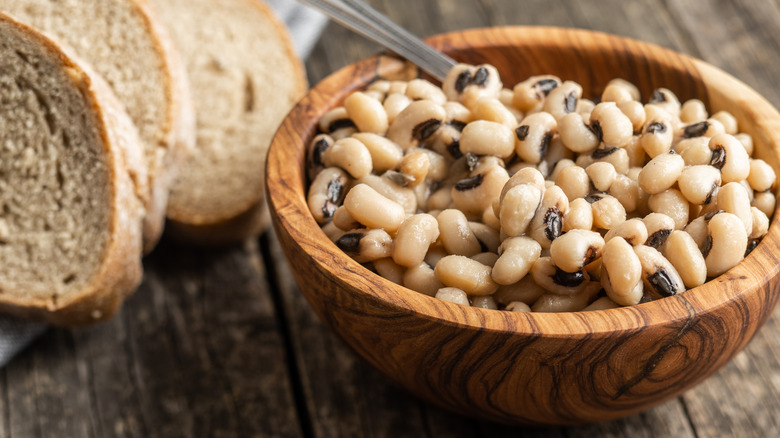The Way Cowboy Caviar Became An Important Texas Standard
What did cowboys really eat in the old West? "Cowboy caviar," also known as "Texas caviar," likely brings to mind an image of cowboys eating a tin of locally caught river fish roe. Actually, as Texas Monthly explains, cowboy caviar's inception was a successful attempt to create a dish that incorporated a Texan ingredient: black-eyed peas.
The popularity of black-eyed peas for cowboys and ranchers isn't all that surprising – black-eyed peas provide such impressive nutrients for the soil, and planting them could even remove the need for fertilizer in other crops, according to a 2022 scientific study (via Science Daily). This makes black-eyed peas a precious little plant, especially in a semi-arid state like Texas where other crops sometimes fail, per the Texas Farm Bureau.
Initially, former New Yorker Helen Corbitt wasn't pleased about moving to Texas in the 1940s to teach cooking, according to the Texan magazine The Alcalde. But eventually, Corbitt began to like the Lone Star state, and it sure learned to love her. After making a name for herself teaching and cooking in Houston, Corbitt was invited to cook for Neiman Marcus's elite Zodiac Room restaurant. One day, she was challenged to create a menu that would include dishes made with Texas products like black-eyed peas, per Texas Monthly. And what she came up with would become, for better or for worse, a staple of Texan cuisine.
Helen Corbitt is the original star of TikTok's viral cowboy caviar video
According to Texas Monthly, Helen Corbitt's original recipe for cowboy caviar was uncomplicated: black-eyed peas pickled with garlic, onion, vinegar, and oil. The simple dish quickly became a huge hit with Texans. As a culinary pioneer, Helen Corbitt's star continued to rise: She served the likes of Charlton Heston and Princess Margaret and was even offered a position as Lyndon Johnson's chef, per The Alcalde. In 1999, Texas Monthly named Corbitt "Tastemaker of the Century" — claiming that before she arrived on the scene, Texans mostly just ate beef, potatoes, iceberg lettuce, and canned fruit salad.
Fast-forwarding to May, TikTok user Bria Lemirande brought Corbitt's locally famous dish out of Texas and onto the national stage when she casually whipped up a modern cowboy caviar recipe that included black beans, corn, bell peppers, olives, mango, and feta. Over the summer, Lemirande continued to post different versions of cowboy caviar featuring ingredients like peaches and even pomegranate seeds, garnering millions of views from her fans, as People later reported.
Is cowboy caviar an example of cultural appropriation?
As Texas caviar shot to 21st-century prominence on social media, others wondered if the recipe was a cultural appropriation and if Helen Corbitt's reputation as the creator of the dish was at all accurate, as Dallas News and other outlets reported. Following a backlash from the Latinx community, Remezcla writer Kiko Martinez identified Bria Lemirande's viral TikTok as part of a larger trend of white social media users taking traditional foods and beverages from Latinx cultures to build up personal brands, asserting that "cowboy caviar" is "basically ceviche or pico de gallo/salsa." (One example included spinning agua fresca as "spa water," with the user including the hashtag "#wellnessjourney" in her post.) As Study Breaks noted, Lemirande later issued an apology to her fans for any inadvertent offense caused by her renditions of cowboy caviar.
However, the matter of appropriation when it comes to cowboy caviar isn't all that clear-cut. Na'atik Mexico explains that pico de gallo, which Corbitt may or may not have used for her Texan caviar recipe, originated in Aztec culture, and traditionally contains tomatoes, green peppers, onions, cilantro, and lime juice. It's also possible cowboy caviar has another progenitor entirely — speaking with Dallas News, Texas Monthly editor José Ralat pointed out cowboy caviar might have strong connections to Hoppin' John, a Southern dish thought to have been created by Black enslaved people around the 1800s.


